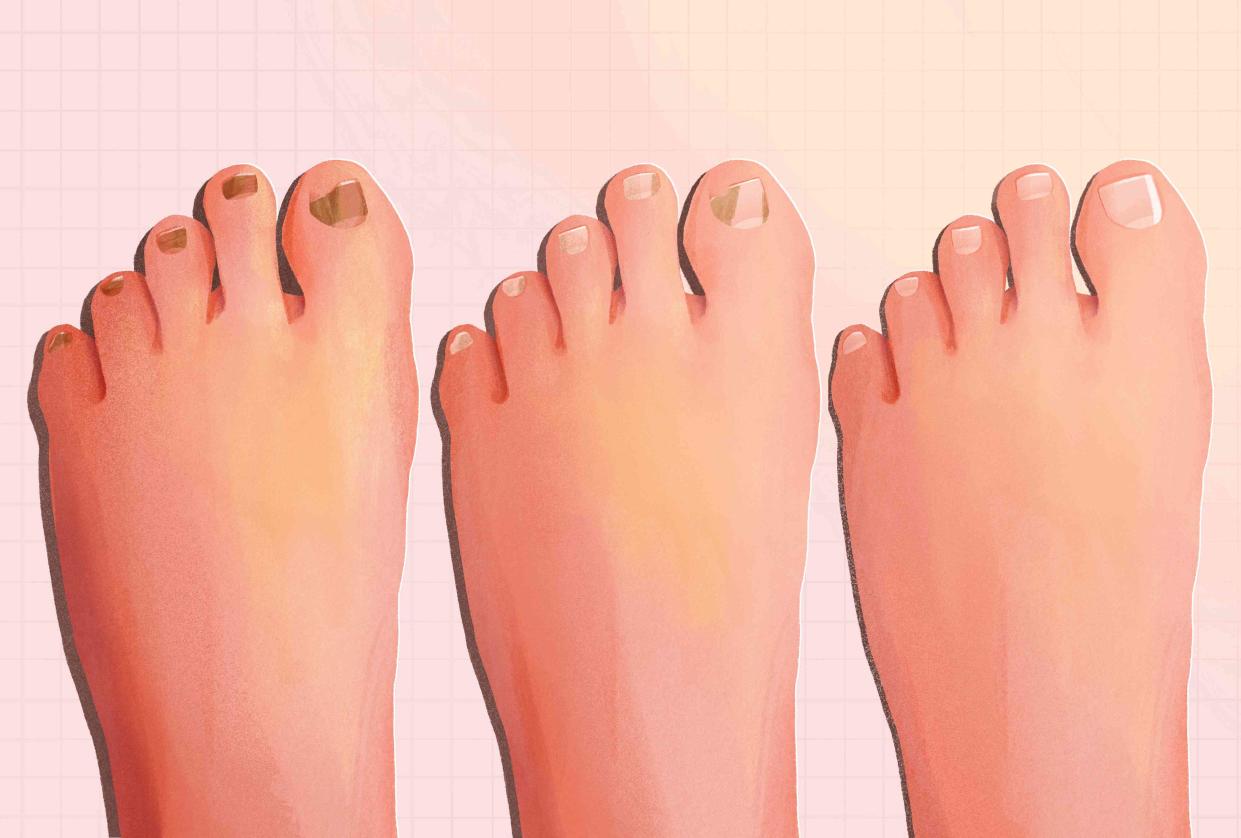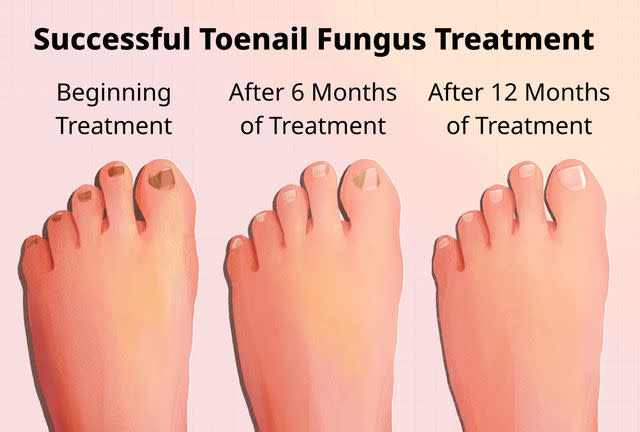What Does Toenail Fungus Look Like When It's Dying?

Illustration by Julie Bang for Verywell Health
Medically reviewed by Danielle McNeil, D.P.M
Fungal nail infections (onychomycosis) can be difficult to treat but can be helped by treatments such as oral and topical antifungal medications. The infection is considered cured when new nail growth is healthy as the nail affected by fungal infection grows out.
This article will discuss how toenails with a fungal infection look compared to healthy ones, what treatments are available, how to support healing at home, and what happens when toenail fungal infections recur or won't go away.

Illustration by Julie Bang for Verywell Health
What Toenail Fungus Looks Like If Treatment Is Working
To determine if the toenail fungus is dying, look at the base of the nail. When the new growth from the base is healthy, the infection is considered clinically cured.
If necessary, mycological (a branch of biology that deals with fungus) cure can be determined with a negative potassium hydroxide (KOH) preparation (the sample is examined under a microscope) and negative fungal culture (a sample is given time to grow to see if fungus is present).
Available Treatments
Treatments that may be used for toenail fungal infection include:
Over-the-counter topical products: Antifungal creams, ointments, or other preparations can be applied on or under the nail. These may help the nails look better, but are not an effective cure for the infection.
Prescription topical treatments: Medications may include Jublia (efinaconazole), Kerydin (tavaborole), and Penlac (ciclopirox). These work best for infections that are in the early stages. Filing the surface of the nail may help the medication better penetrate into the nail. Daily applications are required, and noticeable improvement may take up to a year. Their average cure rate is about 35%.
Prescription oral medications: Sporanox (Itraconazole) or Lamisil (terbinafine) may be used. These tend to be more effective than topical treatments, but can harm the liver. Liver function will need to be checked and monitored. Drug interactions, and interactions with alcohol and the sun are also possible. Because of the risks involved, oral medications are typically used for people with conditions that may be worsened by fungus, such as diabetes or vasculitis.
Natural remedies, such as tea tree oil, have not been well-studied for efficacy in treating toenail fungal infection.
Toenail Fungus Heals in Stages of Nail Regrowth
Toenails that have a fungal infection typically become discolored. They often start with a white spot, and can turn yellow, green, or brown.
Infected toenails may also:
Become brittle
Change shape
Loosen, lift, or separate from the nail bed
Have debris trapped under them
Lose luster or shine on the surface
Have a foul smell underneath them
Once the infection is successfully treated, new growth of healthy nail will occur from the base of the nail. New nail cells push out old nail cells. A healthy toenail looks like a healthy fingernail, with a pinkish color from the tiny blood vessels on which the nail bed sits.
It takes about 12 to 18 months for toenails to be completely replaced by new growth.
Treatment Not Working: Toenail Fungus Sticking Around
Toenail fungal infections can be difficult to treat. Medications are effective against the fungal infection in about 50% of those who use them, and the infection can return.
Depending on the extent of your infection and medical conditions you may have, your healthcare provider may start with topical treatment, which carries less risk.
If topical treatments don't work, your healthcare provider may suggest oral medications, if the benefits of this treatment outweigh the risks, such as potential damage to the liver. Oral medications tend to be more effective than topical.
Self-Care to Promote Toenail Fungus Healing
To help prevent toenail fungal infections, try measures such as the following:
Keep your feet cool and dry.
Avoid footwear that causes or traps excessive sweat.
Wear footwear such as swim shoes or flip-flops in pools and public gyms, and avoid going barefoot in public spaces.
Keep your nails trimmed (straight across) to avoid trauma to the nail.
Throw out or treat footwear or socks infected by fungus.
Address uncontrolled diabetes.
Use a daily antifungal powder or spray as a prophylactic.
Avoid sharing tools like nail files, and ensure nail salons are clean and licensed by your state's cosmetology board (instruments should be sterilized after each use)
Let your feet air out shoe-free when possible.
Wear sweat-wicking socks.
Maintain a clean and hygienic tub and shower surface.
Nail polish and artificial nails will not get rid of a nail infection.
When Toenail Fungus Keeps Coming Back
The relapse rate for toenail fungus infection is up to 53%.
Infection is more likely to return in people who have conditions such as diabetes. Untreated, the infection can spread to other areas such as other nails. Fungal skin infections are also associated with fungal nail infections. It's important to talk to your healthcare provider if you suspect you have a skin infection or that your fungal infection has returned.
If recurrence of toenail fungal infection is a concern, your healthcare provider may suggest removing the nail and using chemicals to destroy the nail matrix. This prevents the nail from growing back.
Contact your healthcare provider or seek immediate medical care if you have:
Signs of infection (such as pain, swelling, redness, or warmth)
Pus draining from the area
Fever
Red streaks leading from the area
New or increased toe pain
Questions or concerns
Toe and Foot Complications in People With Diabetes
It is important for people who have diabetes and those with a weakened immune system to treat toenail fungal infections promptly to avoid possible complications, such as:
Bacterial skin infection
Sores that don't heal and lead to other serious health problems
If you have diabetes or a weakened immune system, see your healthcare provider at the first sign of a toenail fungal infection.
Summary
Toenails that have a fungal infection can be discolored, brittle, and thickened, while healthy toenails are clear and pinkish. The infection is considered cured when a healthy nail is growing from the base of the nail. To help prevent toenail fungal infection, take measures such as keeping your feet cool and dry, wearing footwear in public places, and trimming your toenails.
